
2D only HETCOR pulse program for topSpin2.1 operating system
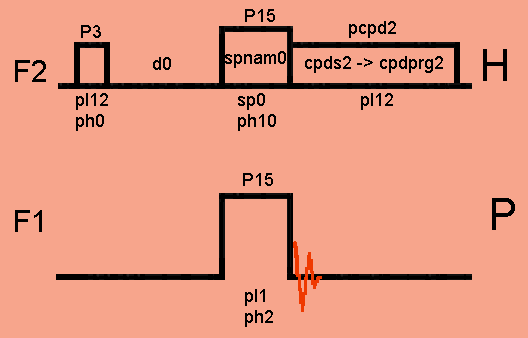
No homonuclear H-H decoupling during t1 period; inf1 = in0.
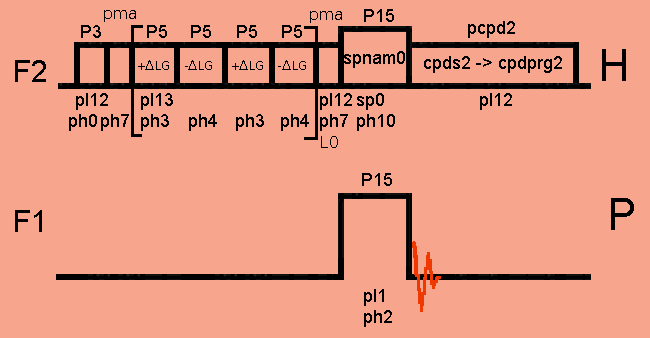
FSLG homonuclear H-H decoupling during t1 period.
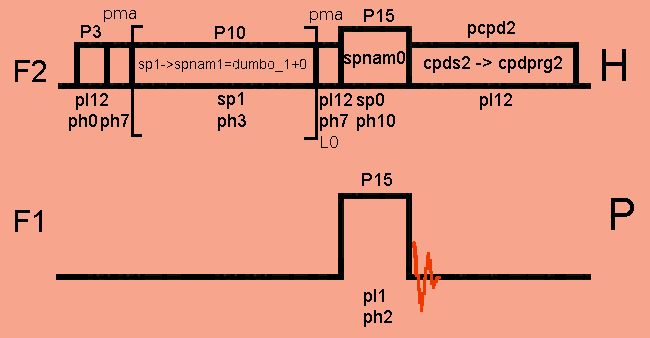
DUMBO homonuclear H-H decoupling during t1 period.
;hxhetcor (TOPSPIN 2.0) ; heteronuclear correlation between protons and X nuclei ; with or without homonuclear decoupling during t1 ; possible decoupling schemes are FSLG, PMLG, and DUMBO ; see e.g.: B.-J. van Rossum, H. Foerster, and H.J.M. deGroot, J. Magn. Reson. 124 (2003) 516-519 ; create dumbo pulse using AU program dumbo ; create pmlg pulse using AU program pmlg_shape ; written by Stefan Steuernagel (031201) ;Avance II+ version ;parameters: ;ns : 2, n*4 ;d1 : recycle delay ;pl1 : power level for X contact ;sp0 : proton power level during contact ;pl2 : =120dB, not used ;spnam0 : e.g. ramp.100 ;spnam1 : lgs-1, lgs-4 or pmlg-36, or dumbo1, set p10 to appropriate multiple of LG period ;pl12: for decoupling and excitation 1H ;sp1: for homonuclear decoupling DUMBO, PMLG ;pl13: for homonuclear decoupling FSLG ;p3 : 1H 90 degree pulse ;p10 : duration of phase modulated shape pulse ;p15 : contact time, short: 50 - 200 us ;pcpd2 : pulse length in decoupling sequence ;phcor3 : phase correction for optimal FSLG peformance: minimize zero frequency glitch in F1 ;cpdprg2 : cw, tppm15, spinal64 ;cnst20 : LG-RF field as adjusted, in Hz used to calculate cnst22 and cnst23 +and - LG frequency ;cnst21 : additional LG offset, usually =0 ;cnst22 : +ve LG offset ;cnst23 : -ve LG offset ;cnst24 : offset for proton evolution under LG, usually 0 - -2000 ;l0 : =0, increment for t1 ;l3 : 1, 2, or 4 for dwell in t1 ;zgoptns : -Dfslg, -Ddumbo, -Dpmlg, -Dnodec ;FnMode : States-TPPI, States, or TPPI for zgoptns -Dnodec ; undefined for all other zgoptns ;mc2 : States-TPPI, if FnMode undefined, in case of States the statement "1m rp0" must be activated ; by removing semicolon at the beginning of the corresponding line ;d0 : =3u ;in_010 : =1/swh {f1}, calculated in program ;nd_010 : 1 ;$COMMENT=HETCOR (CP based), with or w/o homonuclear decoupling during t1, various schemes possible ;$CLASS=Solids ;$DIM=2D ;$TYPE=cross polarisation ;$SUBTYPE=heteronuclear correlation ;$OWNER=Bruker define loopcounter nfid "nfid=td1/2" ;cnst11 : to adjust t=0 for acquisition, if digmod = baseopt "acqt0=1u*cnst11" define pulse pma ;54.7° = magic angle "pma=(p3*547)/900" #ifdef fslg #include <lgcalc.incl> ;in0 : =(0.578*l3*4*p5) 1/sqrt(3) = 0.578, the scaling factor "in0=(0.578*l3*4*p5)" #endif /* fslg */ #ifdef dumbo ;in0 : =0.578*l3*p10 "in0=(0.578*l3*p10)" #endif /* dumbo */ #ifdef pmlg ;in0 : =0.578*l3*p10 "in0=(0.578*l3*p10)" #endif /* pmlg */ 1 ze 2 10m do:f2 d1 ;recycle delay 1u fq=cnst21:f2 (p3 pl12 ph0):f2 ;proton 90° pulse #ifdef nodec ;no homonuclear H-H decoupling during t1 period ;d0 : =0 ;inf1 : =1/swh(f1), increment for t1 "in0 = inf1" d0 #endif /* nodec */ #ifdef dumbo (pma ph1):f2 1u fq=cnst24:f2 3 (p10:sp1 ph3):f2 lo to 3 times l0 (pma ph7 pl12 fq=cnst21):f2 #endif /* dumbo */ #ifdef pmlg (pma ph1):f2 1u fq=cnst24:f2 3 (p10:sp1 ph3:r):f2 lo to 3 times l0 (pma ph7 pl12 fq=cnst21):f2 ;magnetization back to the xy plane for spin-locking #endif /* pmlg */ #ifdef fslg (pma ph1):f2 ;magnetization in the plane perpendicular to the ;effective magnetic field 1u fq=cnst24:f2 3 (p5 fq=cnst22 pl13 ph3):f2 (p5 fq=cnst23 ph4):f2 (p5 fq=cnst22 ph3):f2 (p5 fq=cnst23 ph4):f2 lo to 3 times l0 (pma ph7 pl12 fq=cnst21):f2 ;magnetization back to the xy plane for spin-locking #endif /* fslg */ (p15 pl1 ph2):f1 (p15:sp0 ph10):f2 ;CP contact time 1u cpds2:f2 go=2 ph31 1m do:f2 #ifdef nodec 10m mc #0 to 2 F1PH(ip0,id0) #else 10m wr #0 if #0 zd 1m ip0 ;increment all phases of ph0 by 90° ;for quadrature detection in F1 dimension lo to 2 times 2 4 1m iu0 ;increment counter l0 by 1 lo to 4 times l3 ; 1m rp0 ;in case of States remove semicolon at beginning of line lo to 2 times nfid #endif /* nodec */ exit ph0=1 3 ph1=1 ph2=0 0 2 2 1 1 3 3 ph3=0 ph4=2 ph7=3 ph10=0 ph31=0 2 2 0 1 3 3 1
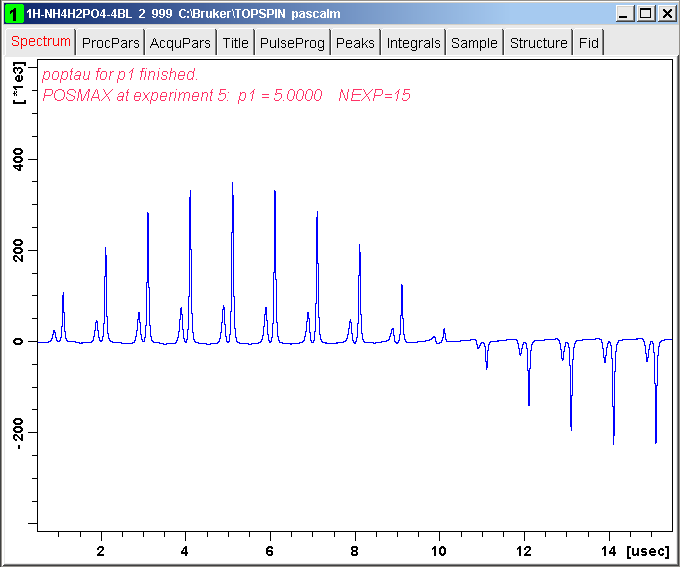
1H 90° pulse duration of NH4H2PO4 in a 4-mm diameter rotor spinning at 14 kHz.
Pulseprogram parameters:
| General | |
| PULPROG | zg |
| TD | 2048 |
| NS | 4 |
| DS | 0 |
| SWH [Hz] | 100000.00 |
| AQ [s] | 0.0102950 |
| RG | 4 |
| DW [µs] | 10.000 |
| DE [µs] | 6.50 |
| D1 [s] | 5.00000000 |
| Channel f1 | |
| NUC1 | 1H |
| P1 [µs] | 5.00 |
| PL1 [dB] | 10 |
| SFO1 [MHz] | 500.2137120 |
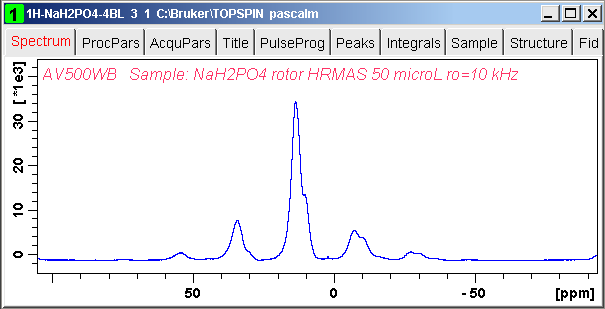
1H MAS spectrum of NaH2PO4 in a 4-mm diameter, 50 µLitre HRMAS rotor spinning at 10 kHz.
Pulseprogram parameters:
| General | |
| PULPROG | zg |
| TD | 2048 |
| NS | 4 |
| DS | 0 |
| SWH [Hz] | 100000.00 |
| AQ [s] | 0.0102950 |
| RG | 4 |
| DW [µs] | 5.000 |
| DE [µs] | 6.50 |
| D1 [s] | 5.00000000 |
| TD0 | 1 |
| Channel f1 | |
| NUC1 | 1H |
| P1 [µs] | 5.00 |
| PL1W [W] | 10.00 |
| SFO1 [MHz] | 500.2137120 |
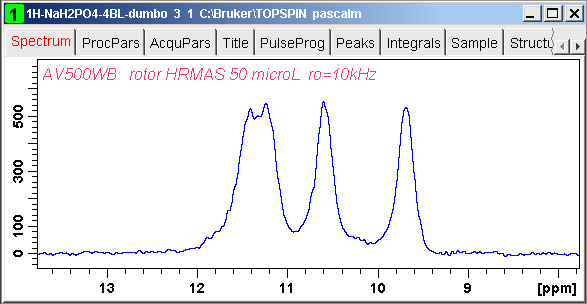
1H windowed DUMBO spectrum of NaH2PO4 in a 4-mm diameter, 50 µLitre HRMAS rotor spinning at 10 kHz.
Pulseprogram parameters for dumbod2:
| General | |
| PULPROG | dumbod2 |
| TD | 700 |
| NS | 4 |
| DS | 0 |
| SWH [Hz] | 8012.82 |
| AQ [s] | 0.0437924 |
| RG | 4 |
| DW [µs] | 62.400 |
| DE [µs] | 4.50 |
| CNST11 | 0.0000000 |
| D1 [s] | 5.00000000 |
| D3 [s] | 0.00000300 |
| d9 [s] | 0.00000260 |
| L11 | 26 |
| P9 [µs] | 2.60 |
| P10 [µs] | 24.00 |
| PL13 [dB] | 2.50 |
| acqu [s] | 0.00000130 |
| count | 748 |
| cycle [s] | 0.00005850 |
| dead [s] | 0.00000120 |
| rest [s] | 0.00003440 |
| Channel f1 | |
| dumbop [µs] | 24.00 |
| NUC1 | 1H |
| P1 [µs] | 2.00 |
| PL1 [dB] | 3.80 |
| PL12 [dB] | 3.80 |
| SFO1 [MHz] | 500.2155921 |
| SP1 [dB] | 2.50 |
| SPNAM1 | dumbo_1+0 |
| SPOAL1 | 0.500 |
| SPOFFS1 [Hz] | 0.00 |
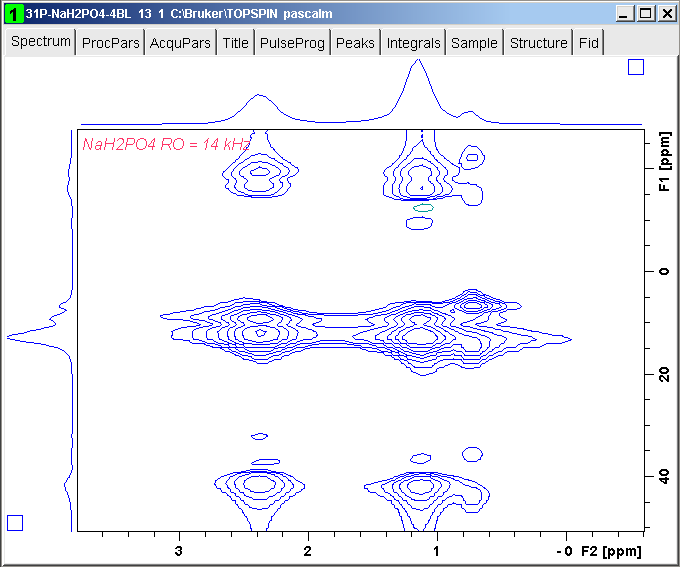
31P{1H} hetcor spectrum of NaH2PO4 in a 4-mm diameter rotor spinning at 14 kHz, no homonuclear H-H decoupling during t1 period.
Pulseprogram parameters:
| General | |
| PULPROG | hxhetcor |
| TD | 3494 |
| NS | 128 |
| DS | 0 |
| SWH [Hz] | 50000.00 |
| AQ [s] | 0.0349900 |
| RG | 4 |
| DW [µs] | 10.000 |
| DE [µs] | 6.50 |
| CNST11 | 0.0000000 |
| D0 [s] | 0.00000300 |
| D1 [s] | 5.00000000 |
| IN0 [s] | 0.00002500 |
| ST1CNT | 16 |
| ZGOPTNS | -Dnodec |
| Channel f1 | |
| NUC1 | 31P |
| P15 [µs] | 1000.00 |
| PL1 [dB] | 9.50 |
| PL1W [W] | 39.34462738 |
| SFO1 [MHz] | 202.4856427 |
| Channel f2 | |
| CNST21 | 0.0000000 |
| CPDPRG2 | spinal64 |
| NUC2 | 1H |
| P3 [µs] | 5.2 |
| PCPD2 [µs] | 9.50 |
| PL2 [dB] | 120 |
| PL2W [W] | 0.00000000 |
| PL12 [dB] | 10.00 |
| PL12W [W] | 32.07678986 |
| SFO2 [MHz] | 500.2167400 |
| SP0 [dB] | 7.00 |
| SP0W [W] | 64.00160980 |
| SPNAM0 | ramp.100 |
| SPOAL0 | 0.500 |
| SPOFFS0 [Hz] | 0.00 |
Acquisition parameters:
| F2 | F1 | |
| Experiment | ||
| PULPROG | hxhetcor | |
| AQ_mod | DQD | |
| FnMODE | STATES | |
| TD | 3494 | 128 |
| NS | 128 | |
| DS | 0 | |
| TD0 | 1 | |
| Width | ||
| SW [ppm] | 246.9311 | 79.9653 |
| SW [Hz] | 50000.00 | 40000.000 |
| IN_F [µs] | 25.00 | |
| AQ [s] | 0.0349900 | 0.0016000 |
| Nucleus1 | ||
| NUC1 | 31P | |
| O1 [Hz] | 971.70 | |
| O1P [ppm] | 4.799 | |
| SFO1 [MHz] | 202.4856427 | |
| BF1 [MHz] | 202.4846710 | |
| Nucleus2 | ||
| NUC2 | 1H | |
| O2 [Hz] | 16740.00 | |
| O2P [ppm] | 33.467 | |
| SFO2 [MHz] | 500.2167400 | |
| BF2 [MHz] | 500.2000000 |